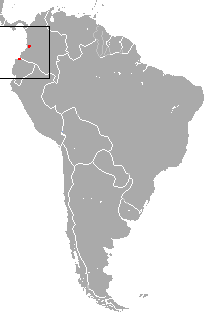| Ecuadorian sac-winged bat | |
|---|---|
| Scientific classification | |
| Domain: | Eukaryota |
| Kingdom: | Animalia |
| Phylum: | Chordata |
| Class: | Mammalia |
| Order: | Chiroptera |
| Family: | Emballonuridae |
| Genus: | Balantiopteryx |
| Species: | B. infusca
|
| Binomial name | |
| Balantiopteryx infusca (Thomas, 1897)
| |

| |
| Ecuadorian sac-winged bat range | |
The Ecuadorian sac-winged bat (Balantiopteryx infusca) is a species of sac-winged bat in the family Emballonuridae. It is found in Colombia and Ecuador.[2] According to the IUCN Red List of Threatened Species, the population trend is decreasing for this species, due to habitat destruction through deforestation.[1] In 2013, Bat Conservation International listed this species as one of the 35 species on its worldwide priority list for conservation.[3]
YouTube Encyclopedic
-
1/3Views:633 015175 3282 086 753
-
HOW I BRING PENS/CARTS ON THE PLANE
-
150+ Minutes of Scary Videos, Images and Stories That You Can't Believe are Actually REAL...
-
All or Nothing: Sr. Clare Crockett (Full Movie)
Transcription
Taxonomy
Balantiopteryx infusca is the sister species of Balantiopteryx io and there are no recognised subspecies.[4]
Appearance
It is larger than Balantiopteryx io, and smaller than Balantiopteryx plicata. [5] It lacks the white trim of Balantiopteryx plicata, and is darker in color.[5]
Habitat and behavior
It is found in the mouth of caves, abandoned mines, and cracks in rock.[4] It prefers to live where there is plenty of light.[1] The bats are sociable and live in colonies; they are also insectivorous.[6]
References
- ^ a b c Tirira, D. (2016) [errata version of 2015 assessment]. "Balantiopteryx infusca". IUCN Red List of Threatened Species. 2015: e.T2531A97206692. doi:10.2305/IUCN.UK.2015-4.RLTS.T2531A22029804.en.
- ^ Simmons, N.B. (2005). "Order Chiroptera". In Wilson, D.E.; Reeder, D.M (eds.). Mammal Species of the World: A Taxonomic and Geographic Reference (3rd ed.). Johns Hopkins University Press. p. 314. ISBN 978-0-8018-8221-0. OCLC 62265494.
- ^ "Annual Report 2013-2014" (PDF). batcon.org. Bat Conservation International. August 2014. Archived from the original (PDF) on July 7, 2017. Retrieved May 1, 2017.
- ^ a b Gardner, Alfred L. Mammals of South America. Chicago: University of Chicago, 2008, p. 194.
- ^ a b Arroyo-Cabrales, Joaquin; Knox Jones, J. (1988). "Balantiopteryx io and infusca". Mammalian Species. 313: 1–3. doi:10.2307/3504205.
- ^ Nowak, Ronald M. Walker's Bats of the World. Baltimore: Johns Hopkins UP, 1994, p. 96.

